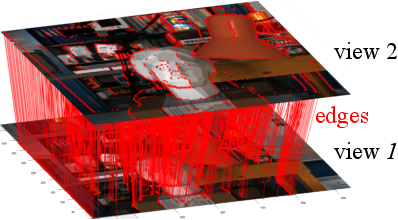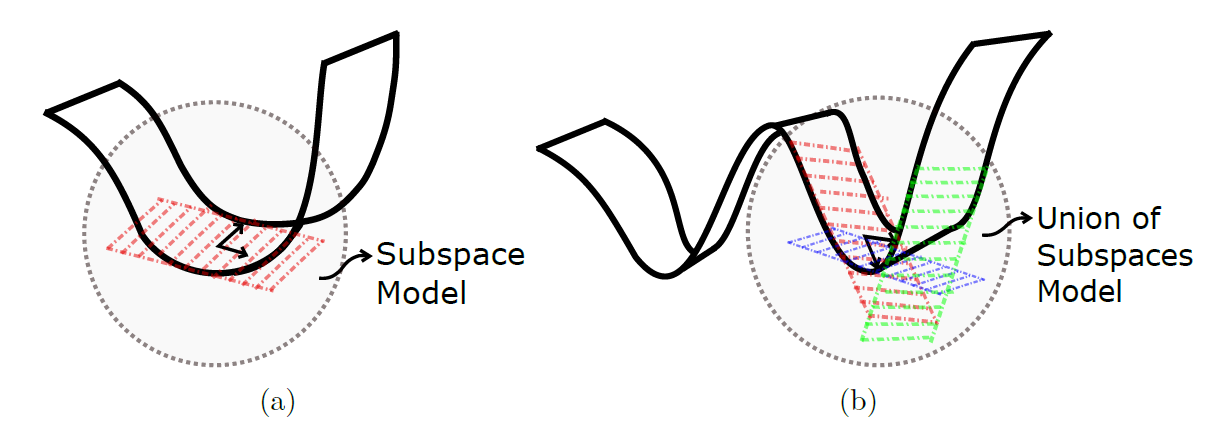Section: New Results
Representation and compression of large volumes of visual data
Sparse representations, data dimensionality reduction, compression, scalability, perceptual coding, rate-distortion theory
Graph-based multi-view video representation
Participants : Christine Guillemot, Thomas Maugey, Mira Rizkallah, Xin Su.
One of the main open questions in multiview data processing is the design of representation methods for multiview data, where the challenge is to describe the scene content in a compact form that is robust to lossy data compression. Many approaches have been studied in the literature, such as the multiview and multiview plus depth formats, point clouds or mesh-based techniques. All these representations contain two types of data: i) the color or luminance information, which is classically described by 2D images; ii) the geometry information that describes the scene 3D characteristics, represented by 3D coordinates, depth maps or disparity vectors. Effective representation, coding and processing of multiview data partly rely on a proper representation of the geometry information. The multiview plus depth (MVD) format has become very popular in recent years for 3D data representation. However, this format induces very large volumes of data, hence the need for efficient compression schemes. On the other hand, lossy compression of depth information in general leads to annoying rendering artefacts especially along the contours of objects in the scene. Instead of lossy compression of depth maps, we consider the lossless transmission of a geometry representation that captures only the information needed for the required view reconstructions.
The goal is thus to develop a Graph-Based Representation (GBR) for geometry information, where the geometry of the scene is represented as connections between corresponding pixels in different views. In this representation, two connected pixels are neighboring points in the 3D scene. The graph connections are derived from dense disparity maps and provide just enough geometry information to predict pixels in all the views that have to be synthesized. GBR drastically simplifies the geometry information to the bare minimum required for view prediction. This “task-aware” geometry simplification allows us to control the view prediction accuracy before coding compared to baseline depth compression methods. In 2015, we have first considered multi-view configurations, in which cameras are parallel.
In 2016, we have developed the extension of GBR to complex camera configurations. In [21], Xin Su has implemented a generalized Graph-Based Representation handling two views with complex translations and rotations between them (Fig. 4). The proposed approach uses the epipolar segments to have a row-wise description of the geometry that is as simple as for rectified views. This generalized GBR has been further extended to handle multiple views and scalable description of the geometry, i.e., a geometry data that is coded as a function of the user navigation among the views.
|
The graph described above links neighboring pixels in the 3D scene as 3D meshes do. This meaningful structure might be used to code the color pixels lying on it. This can be done thanks to the new processing tools developed for signals lying on graphs. These tools rely however on covariance models that are assumed to be suited for the processed data. The PhD work of Mira Rizkallah is currently focussing on the effect of errors in the correlation models on the efficiency of the graph-based transforms.
Sparse and low rank approximation of light fields
Participants : Christine Guillemot, Xiaoran Jiang, Mikael Le Pendu.
We have studied the problem of low rank approximation of light fields for compression. A homography-based approximation method has been proposed which jointly searches for homographies to align the different views of the light field together with the low rank approximation matrices. We have first considered a global homography per view and shown that depending on the variance of the disparity across views, the global homography is not sufficient to well-align the entire images. In a second step, we have thus considered multiple homographies, one per region, the region being extracted using depth information. We have first shown the benefit of the joint optimization of the homographies together with the low-rank approximation. The resulting compact representation compressed using HEVC yields compression performance significantly superior to those obtained by directly applying HEVC on the light field views re-structured as a video sequence.
Deep learning, autoencoders and neural networks for sparse representation and compression
Participants : Thierry Dumas, Christine Guillemot, Aline Roumy.
Deep learning is a novel research area that attempts to extract high level abstractions from data by using a graph with multiple layers. One could therefore expect that deep learning might allow efficient image compression based on these high level features. However, deep learning, as classical machine learning, consists in two phases: (i) build a graph that can make a good representation of the data (i.e. find an architecture usually made with neural nets), and (ii) learn the parameters of this architecture from large-scale data. As a consequence, neural nets are well suited for a specific task (text or image recognition) and require one training per task. The difficulty to apply machine learning approach to image compression is that it is important to deal with a large variety of patches, and with also various compression rates. To test the ability of neural networks to compress images, we studied shallow sparse autoencoders (AE) for image compression in [14]. A performance analysis in terms of rate-distortion trade-off and complexity is conducted, comparing sparse AEs with LARS-Lasso, Coordinate Descent (CoD) and Orthogonal Matching Pursuit (OMP). A Winner Take All Auto-encoder (WTA AE) is proposed where image patches compete with one another when computing their sparse representation. This allows to spread the sparsity constraint on the whole image. Since the learning is made for this WTA AE, the neural network also learns to deal with various patches, which helps building a general-purpose AE. Finally, we showed that, WTA AE achieves the best rate-distortion trade-off, is robust to quantization noise and it is less complex than LARS-Lasso, CoD and OMP.
Data geometry aware local basis selection
Participants : Julio Cesar Ferreira, Christine Guillemot.
Local learning of sparse image models has proven to be very effective to solve a variety of inverse problems in many computer vision applications. To learn such models, the data samples are often clustered using the K-means algorithm with the Euclidean distance as a dissimilarity metric. However, the Euclidean distance may not always be a good dissimilarity measure for comparing data samples lying on a manifold.
In 2015, we have developed, in collaboration with Elif Vural (now Prof. at METU in Ankara, former postdoc in the team), two algorithms for determining a local subset of training samples from which a good local model can be computed for reconstructing a given input test sample, where we take into account the underlying geometry of the data. The first algorithm, called Adaptive Geometry-driven Nearest Neighbor search (AGNN), is an adaptive scheme which can be seen as an out-of-sample extension of the replicator graph clustering method for local model learning. The second method, called Geometry-driven Overlapping Clusters (GOC), is a less complex nonadaptive alternative for training subset selection. The AGNN and GOC methods have been evaluated in image super-resolution, deblurring and denoising applications and shown to outperform spectral clustering, soft clustering, and geodesic distance based subset selection in most settings. The selected patches are used for learning good local bases using the traditional PCA method. PCA is considered an efficient tool to recover the tangent space of the patch manifold when the manifold is sufficiently regular.
However, when the patch manifold has high curvature, which is observed to be the case for images with high frequencies, PCA may not be suitable. It can be seen in Figure 5 that the PCA basis with respect to a manifold fails to approximate the tangent space as the manifold bends over itself. In other words, PCA basis is not adapted when the curvature is too high. On the other hand, it can be seen in Figure 5 that a union of subspaces with respect to a manifold might generate a local model that yields a more efficient local representation of data.
In 2016, we have proposed a strategy to choose between these two kinds of bases locally depending on the local data geometry. This function is defined as the variability of the tangent space in each cluster.
|
Rate-distortion optimized tone curves for HDR video compression
Participants : David Gommelet, Christine Guillemot, Aline Roumy.
High Dynamic Range (HDR) images contain more intensity levels than traditional image formats. Instead of 8 or 10 bit integers, floating point values requiring much higher precision are used to represent the pixel data. These data thus need specific compression algorithms. In collaboration with Ericsson [17], we have developed a novel compression algorithm that allows compatibility with the existing Low Dynamic Range (LDR) broadcast architecture in terms of display, compression algorithm and datarate, while delivering full HDR data to the users equipped with HDR display. The developed algorithm is thus a scalable video compression offering a base layer that corresponds to the LDR data and an enhancement layer, which together with the base layer corresponds to the HDR data. The novelty of the approach relies on the optimization of a mapping called Tone Mapping Operator (TMO) that maps efficiently the HDR data to the LDR data. The optimization has been carried out in a rate-distortion sense: the distortion of the HDR data is minimized under the constraint of minimum sum datarate (for the base and enhancement layer), while offering LDR data that are closed to some “aesthetic” a priori. Taking into account the aesthetic of the scene in video compression is indeed novel, since video compression is traditionally optimized to deliver the smallest distortion with the input data at the minimum datarate.
Cloud-based image compression
Participants : Jean Begaint, Christine Guillemot.
The emergence of cloud applications and web services has led to an increasing use of online resources. Image processing applications can benefit from this vast storage and distribution capacity. In collaboration with Technicolor, we investigate the use of this mass of redundant data to enhance image compression schemes. A region-based registration algorithm has been developped to capture complex deformations between two images. The registration method is then used to exploit both global and local correspondences between pairs of images of the same scene. The region-based registration yields a better prediction (hence reduced prediction errors, see Fig.6) which in turn yields a significant rate-distortion performance gain compared to current image coding solutions.





